Recently, I have been trying to gain a better understanding of how motors work. While searching the interwebs, I found a number of tutorials explaining the magnetic interactions found in motors. But many of these sites and videos failed to explain the mechanics of magnetism itself. So I dusted off my E&M book and went for it. One hour later, and my brain was fried. I had forgotten how complex Electricity and Magnetism was. Doing what any self-respecting engineer would do, I watched an unhealthy amount of YouTube. During my binge, I continued to see "Homopolar motor" and "Simplest Motor" show up. Being curious, I decided to build one and see how it worked.
ReplaceMeOpen
ReplaceMeClose
As you can see, it's about as simple as it gets: a piece of wire, magnet, and a battery. Well, how does it work? Let's take a look!
(Credit: Wikipedia)
Simply put, the Lorentz force is responsible for propelling the motor. To be more exact, it's how the Lorentz force acts on a current-carrying wire. The resultant force is the cross product of current (along a length "l") and the magnetic field. For our purposes, we will ignore length to keep things conceptual.
An easy way to represent the cross product is to think of the Right Hand Rule.
To re-phrase our use of the Lorentz force definition: Force is the product of current as it is orthogonal to the magnetic field. The resulting force must be orthogonal to both current and the magnetic field. What if current and the magnetic field are not perfectly perpendicular? The cross product helps us make this easy. Let's take a simple problem:
The cross product helps us take only the parts of the field as it acts on current. In my example, "B" would represent current, and "A" would represent the magnetic field. To determine the direction of the force, you always start with your thumb along the first vector (Ay), and point your fingers in the direction of the second vector (B). The force will be in the direction your palm is facing. In our case, this is "into the page." The circle with the "X" is supposed to look like arrow fletchings flying away. A arrow coming towards you, or "out of the page," would have a single point.
What if I do the same problem only with C = BxA? Well, what are you waiting for? Try it! The only difference is now your thumb goes along B and your fingers along Ay. You get the same force, but reversed. This demonstrates the importance in the order we solve things. The cross product is not what mathematicians would call commutative. Now, take our example motor diagram above and reverse the current. Following the rules of the cross product and reversing the direction of current reverses the motor! Let's take a look a one running.
ReplaceMeOpen
ReplaceMeClose
(Credit and special thanks to Maurice Woods III!)
The magnetic field is created by the magnet below the battery. This is shown as red field lines traveling from the north to south pole of the magnet. Current is represented by the yellow arrows as it flows through the wire (the magnet is providing the slip ring connection to the bottom of the battery). The green arrows are showing the force created by the interaction.
Well that was cool! What happens when you lay it out flat? You get a linear homopolar motor!!!
ReplaceMeOpen
ReplaceMeClose
Same rules apply F=IxB.
Building one is simple. You just need some form of rails, magnets, and a non-ferrous conductive rod/tube. I found that model rail track was easy to get. I grabbed a box of magnets from inventory, and the copper tube was something I found at the hardware store. Finally, I laser cut some plastic to help me hold it all together. It's important to glue all the magnets in the same orientation or the rod will not continue down the track. This can be done by marking them or checking polarity as you assemble. Special thanks to Riley H. for helping me glue all these magnets together!
Powering it with a current limited DC supply is suggested. We used 5 amps in the video
Assembly view showing magnet orientation
What if we crank up the current? Thanks for asking! Well, for starters, things get hot. So hot that when we add say, 5 million amps, things start to turn to plasma.
(Credit: Wikipedia)
The need for an external magnetic field is also removed. Passing current through a wire creates its own magnetic field. This is governed by Ampère's circuital law. We'll save that topic for a later date. Now, how is this useful? There are plans to use systems like this to put satellites into orbit without burning rocket fuel. Time will tell if it works out!
This was a great tangent I took while writing the new Motor Tutorial. I learned a lot about magnetism, and it really solidified my understanding of the subject. Check it out and see how some of these concepts are put into the context of a motor you might actually use.
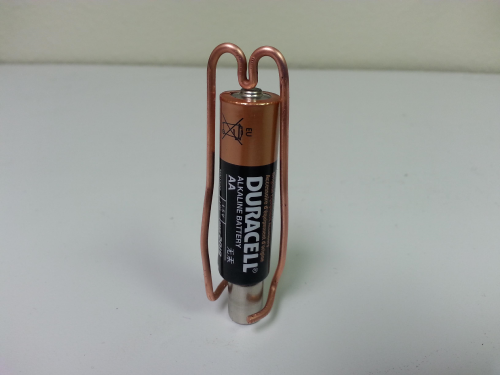
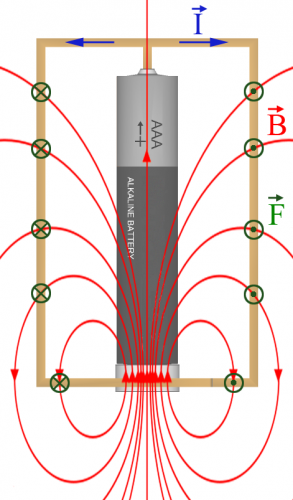

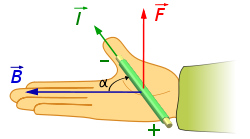
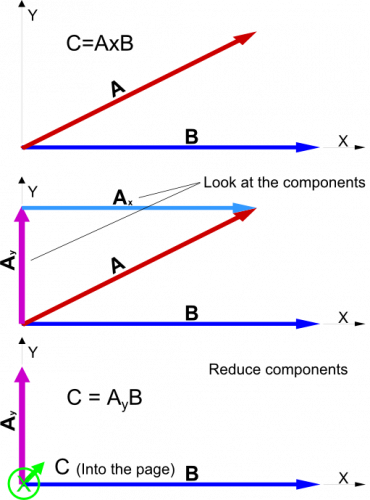
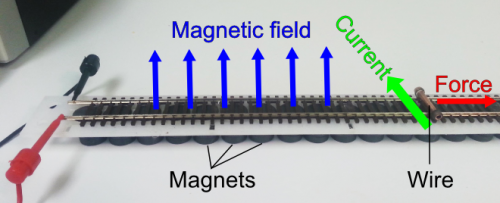
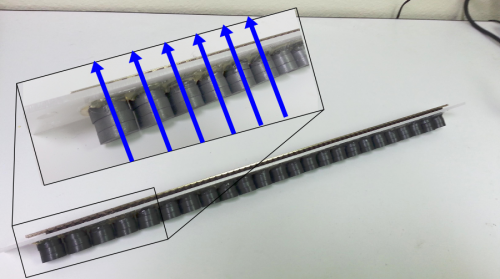
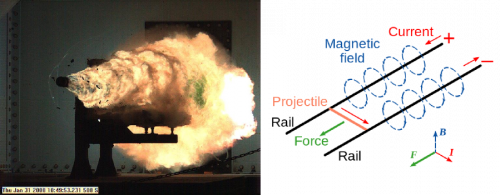






Fun Fact: The IEEE logo is actually the Right Hand Rule! Check it out here
I never payed attention to the logo, nice! Good to know being a member n' all. =)
I ought to bring my course materials out on electromagnetics and electrostatics and apply them. Would be a good refresher. =)
I have one on my desk right now. copper wire, a couple of NdFeB magnets, and a double-A battery. I dimple the end-cap of the battery so the wire stays on track.
Brushed DC motors have been around forever. And in the last 10 years, Brushless motors have become all the rage with RC enthusiast. Why don't people use homopolar motors in their devices more often?
Nice Tutorial! I too remember the brain melting strangeness that is E&M, I think that class caused me some PTSD and how I passed it I have no clue what so ever.
Not much to do with motors but another fun magnet trick is to create a Halbach array which creates almost a true mono-pole. check it out http://en.wikipedia.org/wiki/Halbach_array
I just saw a tv show about space travel and how they would be using plasma jets. The scientist said that they would contain the plasma in magnetic fields, since there was no material that could withstand the heat, which was supposed to be several times hotter than the sun.
I read it. Didn't really understand. I think adding the formulas confused the actual "this is how the magnetic field gets created". Granted I know it's all about the formulas, but couldn't quite make the translation.
http://www.evilmadscientist.com/2006/how-to-make-the-simplest-electric-motor/ Shows an even simpler motor, and a little explanation.
If you take one of the arms off my motor you get the same thing. The only difference is the arm spins instead of the magnet. I looked at Evil Mad Scientist's blog while writing this and decided to take a different approach. They have another great article here , where they describe the same forces but acting on water. It's a great read!
Neat demonstration. Explanation should be "commutative" rather than "communiative".
Doh! Good catch!
I have a question here. The Laplace's Law uses current and wire`s lenght and the Lorentz force uses Charge and velocity. am I wrong? are my books wrong?
You are not wrong. If my understanding is correct the Laplace Force is the macro product of the Lorentz force acting on the individual charges. I originally wrote this describing the Laplace Force but I found no mention of it in my E&M book. It's very possible Griffiths left it out to keep things simple. I'm looking through the rest of my book to see if it's mentioned elsewhere.
Thanks for the input!
I'd take CaseyTheRobot more seriously if he had some sort of moustache that commanded respect... but this is a well done post!